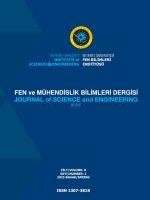KÜRESEL TEKSTİL TEDARİK LOJİSTİĞİNDE SÜRDÜRÜLEBİLİRLİK İÇİN YAKIN TEDARİKÇİ (NEARSHORING) STRATEJİSİNİN KULLANIMININ CO2 EMISYON ÜZERİNE ETKİSİ
Şirket çıkarlarının toplumsal çıkarlarla çatışmadığı, toplumsal ve çevresel konuların şirketlerin sorumluluğu haline geldiği yeni dünya düzeni sürdürülebilirlik kavramını ortaya çıkarmıştır. Bu bağlamda Avrupa Parlamentosu'nun açıklamalarına göre üretim ve atık miktarı göz önünde bulundurulduğunda çevreye en zararlı sektörlerden biri olan tekstil sektörü için de bu kavram oldukça önemlidir. Öte yandan tekstil sektörü, küreselleşme ve maliyet kısıtlamaları altında birbirinden uzak konumdaki birçok zincir üyesinin birlikte hareket etmeye çalıştığı karmaşık bir tedarik zincirine sahiptir. Bu durum tekstil sektörünün sürdürülebilirlik çalışmalarını zorlaştırmaktadır. Ancak sürdürülebilir bir tedarik zinciri yapısı oluşturan ve bu yapıyı sürekli iyileştiren işletmelerin rekabet avantajı yaratması beklenmektedir. Bu çalışmada, çevresel sürdürülebilirliği iyileştirmek için yakın tedarikçi (Near Shore) stratejisi benimsenmiştir. Bu nedenle, nearshoring ile CO2 emisyonlarının taşıma alanındaki azalma miktarını anlamak için, geçmiş ve planlanan tedarik taşımalarının emisyonları hesaplanmıştır. Tekstil şirketi tedarikçilerinin %30 unu FM (Full Merchandised) adı verdikleri yakın bölge tedarikçilerinden seçerek, taşımadan kaynaklı CO2 emisyonlarındaki azalış ile, iki yılda 669 t CO2e azalma sağladığı ortaya konulmuştur. Önümüzdeki 10 yıllık dönemde toplam emisyon azaltımı, nakliye için 20122 ton CO2 e'dir. Bu araştırmanın tedarik taşımaları süreci açısından değer yaratacak bir sürdürülebilirlik çalışması olacağı açıktır.
Anahtar Kelimeler:
Sürdürülebilir Tekstil Tedarik Zinciri, CO2 Emisyonu Hesaplama, Nearshoring, Ulaştırma Kaynaklı CO2 Emisyonu
THE EFFECT OF USING NEARSHORING STRATEGY ON CO2 EMISSIONS FOR SUSTAINABILITY IN GLOBAL TEXTILE SUPPLY LOGISTICS
The new world order, in which company interests do not conflict with social interests, and social and environmental issues become the responsibility of companies, has revealed the concept of sustainability. In this context, according to the statements of the European Parliament, sustainability is also important for the textile sector, which is one of the most environmentally harmful sectors according to the amount of production and waste. On the other hand, the textile industry has a complex supply chain in which many distant chain members try to act together under globalization and cost constraints. This situation makes the sustainability studies of the textile sector difficult. However, businesses that create a sustainable supply chain structure and continuously improve this structure are expected to create a competitive advantage. In this study, the nearshore supplier strategy is adopted to improve environmental sustainability. Therefore, old inbound transpostation has calculated to understand reduction of CO2 emissions. Used calculation methods are placed in EN 16258. With this new sustainable idea, the textile company used %30 nearshore suppliers are called FM (Full Merchandised) at first two years. The reduction of CO2 emissons rate for inbound transportation became 669 t CO2 e at the end of 2022. The total emission reduction during the next 10-years period is 20122 tons CO2 e for transportation. It is obvious that this research will be a sustainability study that will create value in terms of the inbound supply process.
Keywords:
Sustainabile Textile Supply Chain, Calculation of CO2 emissions, Nearshoring, CO2 Emissions Based on Transport,
___
- Binh, N., & Tuan, V. (2016). Greenhouse gas emission from freight transport-accounting for the rice supply chain in Vietnam. Procedia CIRP, 40, 46–49. https://doi.org/10.1016/j.procir.2016.01.051
- CLECAT (European Association for Forwarding, Transport, Logistics and Customs Services). (2023, March 20). Calculating GHG emissions for freight forwarding and logistics services. https://www.clecat.org/media/CLECAT_Guide_on_Calculating_GHG_emissions_for_fr eight_forwarding_and_logistics_services.pdf
- Jovanovic, B., Ghodsi, M., van Zijverden, O., Kluge, S., Gaber, M., Mima, R., ? Mandi?, M. (2021). Getting stronger after COVID-19: Nearshoring potential in the Western Balkans (No. 453). WIIW Research Report. https://wiiw.ac.at/getting-stronger-after-covid-19- nearshoring-potential-in-the-western-balkans-dlp-5814.pdf
- Klein, J., Geilenkirchen, G., & Hulskotte, J. (2012). Methods for calculating the emissions of transport in the Netherlands. Statistics Netherlands Report.
- Li, X., Lv, T., Zhan, J., Wang, S., & Pan, F. (2022). Carbon Emission Measurement of Urban Green Passenger Transport: A Case Study of Qingdao. Sustainability, 14(15), 9588. https://doi.org/10.3390/su14159588
- Majumdar, A., & Sinha, S. (2018). Analyzing the barriers of green textile supply chain management in South-east Asia using interpretive structural modeling. Sustainable Production and Consumption, 17, 176-187. https://doi.org/10.1016/j.spc.2018.10.005
- Manavalan, E., Thanigai M.A., & Kandasamy, J. (2021). Chapter 14 - Sustainable supply chain management in manufacturing industries, In K. Gupta & K. Salonitis (Eds.), In Handbooks in Advanced Manufacturing, Sustainable Manufacturing, (pp. 367-389). Elsevier.
- Mock, P. (2016). Policy options to reduce emissions from the road transport sector in Turkey. IPM-Mercator Policy Brief, 1-13. https://ipc.sabanciuniv.edu/Content/Images/Document/policy-options-to-reduceemissions- from-the-road-transport-sector-in-turkey-31c3c2/policy-options-to-reduceemissions- from-the-road-transport-sector-in-turkey-31c3c2.pdf
- Mubarak, A., & Zainal, F., (2018). Development of a framework for the calculation of co2 emissions in transport and logistics in southeast asia. International Journal of Technology, 9(4), 787–796. https://doi.org/10.14716/ijtech.v9i4.1432
- Müller-Dauppert, B. (2016). Production nearshoring in Europe and their consequences to the supply chain. Gazdaság és Társadalom, 8(2), 5-25. https://doi.org/10.21637/GT.2016.2.01.
- Saygılı, E., Saygılı, A. T., ? Gören Yargı, S. (2019). An analysis of sustainability disclosures of textile and apparel companies in Turkey. Textile and Apparel, 29(3), 189-196. https://doi.org/10.32710/tekstilvekonfeksiyon.471049
- Standard EN 16258. (2012). Methodology for calculation and declaration of energy consumption and greenhouse gas emissions of transport services. German from Beuth Verlag. https://www.beuth.de/de
- USEPA. (2018). Fast facts on transportation greenhouse gas emissions. https://www.epa.gov/greenvehicles/fast-facts-transportation-greenhouse-gasemissions
- ISSN: 1307-3818
- Başlangıç: 2007
- Yayıncı: Beykent Üniversitesi
Sayıdaki Diğer Makaleler
GERÇEK HAYAT AKTARMA PROBLEMİNE TAM ÇÖZÜM
Zehra HAFIZOĞLU GÖKDAĞ, Salih CEBECİ
TEDARİK ZİNCİRİ DİRENCİLİĞİNİ ARTIRMAK İÇİN DİJİTALLEŞME OLASILIKLARI VE SINIRLARI
Marc-andré WEBER, Peter D. FRANKE, Ulrike AUMUELLER
Türkiye’deki Akıllı Kargo Dolabı Uygulamaları
TERSİNE LOJİSTİKTE DİJİTALLEŞMENİN KRİTİK FAKTÖRLERİ ÜZERİNE BİR ÇALIŞMA
